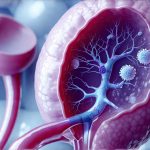Interstitial Cystitis (IC), also known as Bladder Pain Syndrome (BPS), is a chronic condition causing bladder pain and urinary frequency/urgency. It’s often misunderstood, frequently misdiagnosed, and can significantly impact quality of life. While the exact cause remains unknown, it’s believed to involve multiple factors including inflammation, nerve damage, and potential autoimmune responses within the bladder lining. The experience of IC is highly individual; some people report mild discomfort while others endure debilitating pain that interferes with daily activities like work, sleep, and social interactions.
Diagnosis can be challenging because symptoms overlap with other conditions such as urinary tract infections (UTIs), overactive bladder, and pelvic floor dysfunction. There isn’t a single definitive test for IC, leading to what is often described as a “diagnosis of exclusion”. This means doctors will rule out other possible causes before considering an IC diagnosis. Understanding the potential signs and symptoms is crucial for seeking timely evaluation and exploring available management strategies. It’s important to remember that feeling like something isn’t right with your urinary health warrants investigation, even if initial tests come back negative. Perhaps understanding why you might feel like you have a UTI after treatment can help differentiate symptoms.
Recognizing the Core Symptoms of Interstitial Cystitis
The hallmark symptom of IC is persistent bladder pain or discomfort, which can range from mild aching to severe, burning sensations. This pain is often described as being located in the lower abdomen, but it can also radiate to the back, pelvis, and even thighs. Unlike a UTI where pain typically intensifies with urination, IC pain may worsen as the bladder fills, or be present regardless of whether the bladder is full or empty. Another common feature is urinary frequency – needing to urinate much more often than normal—and urgency, an overwhelming and sudden need to urinate that can be difficult to control. These symptoms are not always constant; they can flare up and subside in unpredictable cycles, making it challenging to track and understand the progression of the condition.
It’s also important to note that IC isn’t simply about frequency or urgency; the nature of the discomfort is key. Many individuals describe a feeling of pressure, fullness, or aching even shortly after emptying their bladder. Some experience pain during sexual intercourse (dyspareunia), which can be a significant source of distress. These symptoms often lead to anxiety and fear surrounding urination, creating a vicious cycle where anticipation of pain exacerbates the condition. Because these are non-specific symptoms, it is easy for IC to be overlooked or attributed to other conditions, leading to delays in proper diagnosis and care. Understanding spotting early signs of interstitial cystitis can speed up the process.
The impact of IC extends beyond physical discomfort. The chronic nature of the illness can lead to significant emotional distress, including anxiety, depression, fatigue, and social isolation. Individuals may find themselves limiting their activities, avoiding social events, or struggling with sleep due to persistent pain and frequent urination. This underscores the importance of a holistic approach to management that addresses both the physical and psychological aspects of IC.
Distinguishing IC from Other Conditions
Differentiating IC from other conditions is one of the biggest challenges in diagnosis. A urinary tract infection (UTI) often presents with similar symptoms – frequency, urgency, and pain – but typically has a more acute onset and responds to antibiotic treatment. If you’ve had multiple negative urine cultures yet continue experiencing UTI-like symptoms, it raises suspicion for IC. Overactive bladder (OAB) also shares some overlapping features, like urinary frequency and urgency, but is generally characterized by a lack of pain or discomfort between urination episodes.
Pelvic floor dysfunction can mimic IC symptoms because the pelvic floor muscles support the bladder and urethra; when these muscles are tight or dysfunctional, they can contribute to urinary problems and pelvic pain. It’s common for individuals with IC to also have some degree of pelvic floor dysfunction, making it essential to assess both conditions during evaluation. Finally, other conditions like endometriosis, fibromyalgia, and irritable bowel syndrome (IBS) can cause chronic pain in the pelvic region, potentially masking or mimicking IC symptoms. A thorough medical history, physical exam, and appropriate diagnostic testing are vital for accurate diagnosis. It’s also important to consider if can you have cystitis symptoms from bladder stones as a potential cause.
The Role of Flare-Ups and Remissions
Interstitial Cystitis often follows a pattern of flare-ups and remissions. Flare-ups involve periods where symptoms become significantly more intense and debilitating, while remissions represent times when symptoms subside or are less bothersome. Identifying your personal triggers for flare-ups can be incredibly helpful in managing the condition. Common triggers include:
- Certain foods and beverages (e.g., caffeine, alcohol, spicy foods, acidic fruits)
- Stress and emotional distress
- Physical activity or prolonged sitting
- Sexual intercourse
- Changes in weather or climate
Keeping a symptom diary to track your flare-ups, potential triggers, and associated activities can provide valuable insights for customizing your management plan. It’s important to remember that even if you’re experiencing remission, the underlying condition is still present, and vigilance is required to prevent future flare-ups. Lifestyle modifications, stress management techniques, and adherence to any prescribed treatment plans are crucial during both phases of the illness.
Diagnostic Approaches and Tests
Diagnosing IC typically involves a process of exclusion, as mentioned earlier. A doctor will start by taking a detailed medical history, asking about your symptoms, their duration, and potential triggers. They’ll also perform a physical exam, including a pelvic exam for women, to rule out other possible causes. Urinalysis is usually the first step – to confirm there’s no UTI present – followed by urine cultures if needed. Cystoscopy, where a small camera is inserted into the bladder, can help visualize the bladder lining and identify any abnormalities.
However, cystoscopy isn’t always definitive for IC, as some individuals with the condition have normal-appearing bladders. The Gold standard test historically used was potassium chloride sensitivity testing which involved instilling solutions of varying concentrations into the bladder to assess pain response. However, this is less frequently performed now due to its potential for discomfort and limited reliability. Biopsies of the bladder lining may be taken during cystoscopy to look for microscopic signs of inflammation or other abnormalities. Finally, it’s important to rule out other conditions that can cause similar symptoms through appropriate testing – such as blood tests for autoimmune markers or imaging studies to assess pelvic organs.
Management Strategies and Living with IC
There is currently no cure for Interstitial Cystitis, but a range of management strategies can help alleviate symptoms and improve quality of life. Treatment plans are individualized, tailored to the severity of your symptoms and specific triggers. Lifestyle modifications play a crucial role in managing IC. This includes dietary changes (eliminating potential bladder irritants), stress reduction techniques (yoga, meditation, deep breathing exercises), and regular exercise (avoiding high-impact activities that could exacerbate pain).
Pelvic floor physical therapy is often recommended to address pelvic floor dysfunction, which commonly coexists with IC. A trained therapist can teach you exercises to strengthen or relax your pelvic floor muscles, improving bladder control and reducing pain. Pharmacological treatments may include medications such as pentosan polysulfate sodium (Elmiron), amitriptyline, or other antidepressants that have been shown to help manage IC symptoms. However, medication effectiveness varies greatly from person to person, and side effects should be carefully considered. More advanced treatment options, reserved for severe cases unresponsive to conservative management, might include bladder instillations (introducing medications directly into the bladder) or, in rare instances, surgery.
Living with a chronic condition like IC requires self-compassion and ongoing support. Joining a support group can provide a sense of community and allow you to connect with others who understand your experience. Remember that you are not alone, and seeking help is a sign of strength, not weakness. It’s essential to advocate for yourself and work closely with your healthcare team to develop a management plan that effectively addresses your individual needs and goals. Recognizing first signs of interstitial cystitis can help you proactively manage the condition.





















